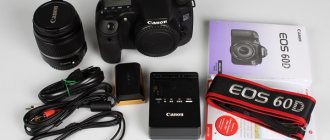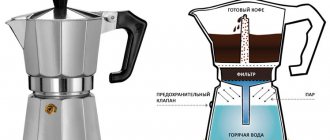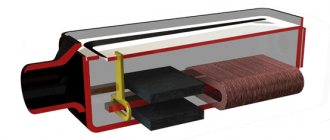Author: Evgeny Zhivoglyadov. Date of publication: October 28, 2015. Category: Articles.
Photographs are the best opportunity to preserve the memory of the most pleasant and significant moments of life. Previously, to get a beautiful photograph you had to spend a lot of time and money, but today, thanks to modern technologies, anyone can become a photographer; all that remains is to understand how to choose the right SLR camera in order to take high-quality pictures. To do this, you will need to understand the main characteristics and options that the camera may have. Of course, it is worth taking into account the cost of a DSLR, which will be several times higher than a standard point-and-shoot camera. Basically, many people reason like this: “I’m not going to become a world-famous photographer, but I just want to take pictures at family events or on vacation, so why spend money on a professional unit or action camera, it’s better to buy a more expensive point-and-shoot camera.” Alas, this is an erroneous reasoning, because later, when looking through a photo album, you will be very surprised to see distorted faces, red eyes and strange highlights and reflections there. Why can't an expensive digital camera take such high-quality pictures as a DSLR?
A few words about SLR and digital cameras
What does a SLR camera mean? This is a camera that works on the following principle: light passing through the lens is directed to a diaphragm, which regulates the volume of light flux. After this, the light hits the mirror, from which it is reflected and redirected to the viewfinder. The viewfinder and gripper lenses are one piece. In addition, such devices use a special digital matrix designed to record images.
To understand what a “DSLR” is, you need to understand how a SLR camera differs from a digital one. The second one is very popular due to its low cost, compactness and ease of use. But, in the viewfinder of a regular digital camera, the image enters through a separate small lens, which is most often placed above the main one.
DSLR cameras are valued by more “advanced” users. Thanks to sensitive lenses and various shooting modes that are manually adjusted, professional units can take amazing pictures that are more than just a regular “photo” for a social network.
In addition, SLR cameras consist of several parts: attached optics (lenses) and a “body”. In terms of technology, DSLRs have come a long way and have become thinner and smarter devices. The quality of the photographs will undoubtedly differ from those taken with a point-and-shoot camera. There is excellent detail, shooting speed, bright colors, the ability to blur, focus and much more.
Therefore, to the question: “Which is better, DSLR or digital camera?” There is only one correct answer - it’s better to buy an inexpensive DSLR than to spend money on an expensive point-and-shoot camera, especially since a smartphone can handle the functions of the latter perfectly.
And now a little about the characteristics that you need to pay attention to when choosing a high-quality SLR camera.
Reflex camera
What is a SLR camera? The first type of cameras is more complex due to its multi-component nature and operating principle. A DSLR also has more functions and modes than a simple compact. DSLR cameras have many lenses inside them, so a significant disadvantage from DSLR devices immediately appears - such a camera cannot be dropped and is better carried in a special bag or case.
The DSLR consists of two parts: Body or body, body plus kit lens. What does this mean among photographers? The body is the body itself, which contains all the glass and hardware, and the other half is the removable eyepieces.
As standard, all models come with a fairly ordinary lens, with which you can still get very good pictures. Their quality is far superior to a simple system unit.
Important! If you want to practice photography as an art, shoot distant or moving objects, nature, or turn to portrait photography, you will need to purchase different lenses: portrait, wide-angle, lens with a good zoom (increase), etc.
Inside the lens itself, unlike a digital camera, you can see lenses standing in a row and a diaphragm - a special plate that controls the amount of light falling on the matrix. Noise and color reproduction, and the overall quality of the entire photograph, depend on a properly functioning aperture.
An image using a SLR camera is obtained as follows:
- Light passes through the lenses.
- Then it hits the diaphragm.
- After the diaphragm, it floods the translucent mirror, dividing into two light beams. The first one is sent through rows of mirrors and passes a convex lens.
- The next stage is the pentaprism, where the light beam splits into an image and goes into the viewfinder. There the picture is already in the correct form, not upside down. And we see the result that we want to get by controlling photographic equipment.
- The second beam of light goes into a focusing system built on electronic sensors. They calculate whether an object is in focus. If not, then the lenses begin to shift a few degrees to make the image clear and “catch” focus.
- At the very end, when these two parallel processes come together and the photographer is satisfied with the image in the viewfinder, it’s time to press the shutter button. After which the mirror system moves aside, and the light completely falls on the matrix, fixing the desired image on it. Photo is ready!
Matrix
The camera matrix is the sensor that is responsible for image quality, so how good your pictures will be directly depends on it. The principle of its operation is the same as that of a frame on an old film unit. Passing through the lens, the light falls on the matrix, due to which the image is captured. Essentially, this element is a semiconductor wafer containing thousands of light-sensitive cells (pixels). Each cell captures light and converts it into an electrical charge, which, under the influence of the processor, turns into a picture.
There are two parameters that you need to pay attention to when choosing a matrix:
- Permission. This indicator is responsible for the number of pixels that make up the matrix. For a high-quality photo there should be 10-12 of them, this will be enough;
- Size. This parameter is measured in millimeters. The larger the matrix, the better pictures you will get.
Important! A resolution of 10-12 megapixels is more than enough for a high-quality photo. All statements that there should be more of them are nothing more than a marketing ploy by manufacturers. Therefore, it is better to prefer a camera with a large matrix, but with the lowest resolution; such a camera will take better pictures.
Also, when choosing a matrix, you should pay attention to its type, namely: CMOS (CMOS - complementary metal-oxide-conductor) or CDD (CCD - charge-coupled device). Each of them has its own characteristics, but there are no striking differences between them. For example, devices with CMOS sensors cost much less, consume slightly less power, and operate slightly faster. That is why, when deciding how to choose a semi-professional SLR camera, it is better to choose such inexpensive models.
The next thing you need to pay attention to is the matrix format. Today there are two types: full frame (36x24 mm) or cropped (crop). Smaller (cropped) models are more suitable for amateurs, that is, people who do not plan to earn money with a camera. This is primarily due to the low price of such cameras, and optics for cropped models are also inexpensive. And the money saved can be spent on tripods for SLR cameras, lenses and much more.
Full-frame models will cost up to 200,000 rubles; due to the high quality of the images, such models are mainly purchased by “seasoned” photographers involved in studio shooting.
Last, but not least, the parameter that is worth paying attention to is the light sensitivity of the matrix (ISO). Like resolution, this option is very often used in advertising, saying that a high ISO value guarantees better light perception by the camera. In fact, everything is not quite like that. The thing is that a high sensitivity value really allows you to take a clearer picture in a dark room, but at the same time this can be reflected in the picture in the form of interference and noise. Therefore, it is not necessary to say that the photosensitivity indicator affects the image quality (in a good sense).
Design and features of a SLR camera
The components of DSLRs are no different from compact digital point-and-shoot cameras. But there is a difference in the principle of operation. They also consist of a body and a lens.
SLR camera body
Let's look at the components:
- matrix;
- mirror shutter;
- viewfinder;
- the screen on which we view photos;
- buttons.
Important! Let's look at the “travel” of light in cameras. The lens of the lens refracts the light that enters it. Next, the light follows the translucent mirror, changes direction and hits the viewfinder. It is through it that the photographer looks at the object he wants to capture. Then a portion of the remaining light falls on another mirror, and then on the focusing sensor. Thanks to this sensor, everyone’s favorite photos with a blurred background appear.
The moment the photographer presses the treasured button, the translucent mirror rises, all the light follows directly onto the matrix, which completes all these manipulations with the appearance of the photograph on the screen.
Lens
Often, DSLR lenses cost more than the camera itself. And this is not surprising! All the characteristics of the future photo depend on this element.
Inside the lens of an SLR camera there are also lenses and aperture. The difference is in the number of lenses and the structure of the diaphragm. You can change lenses based on the photographer's intent. They can be telescopic (for long-distance photography), wide-angle (for landscapes), etc. Using different lenses, the photographer has the opportunity to adjust many shooting parameters.
Lenses
Since a SLR camera is essentially divided into two parts: “body” and “glass,” there are two types of device configuration:
- Kit. Together with the camera body, you receive the lens most suitable for the unit, which is included in the kit. This option is more suitable for novice photographers, since it is difficult to immediately understand which “glass” and how to work. Spending a large sum on a separate lens that you cannot use is not advisable;
- Body. Based on the translation, you can understand that when buying a camera in this configuration, you will only receive the “body” without a lens, which you will have to choose yourself based on your preferences;
- Double Kit. The most optimal option for “beginners”, since in this configuration you will receive several lenses for your camera.
Good to know! The opinion that for high-quality photographs you need to purchase 2-3 separate expensive lenses is not true. The fact is that most people are happy to shoot with “whale glass” and do not experience any inconvenience.
About modern digital and SLR cameras
SLR cameras are currently available in two types:
- Digital;
- Film.
Important: The main difference between a DSLR camera is the ability to see the image you are shooting directly in the viewfinder. In this form, it is projected onto the film or inserted matrix.
The light beam passes through the lens and is reflected in the mirror, which directs it directly into the viewfinder. When photographing occurs, the mirror moves to the side, the stream of light directly hits the film (matrix). This way you get the shot you had in mind in advance.
Moreover, despite the rapid development of digital technology, many professionals prefer to work with film. However, for an amateur, digital technology is preferable, because Further storage and processing of files on digital media is much easier.
One of the advantages of a modern camera is the presence of a built-in display. With its help, the photographer can structure the frame. Rotating the display allows you to shoot with your arms raised high above your head.
Basically, modern cameras are equipped with a self-adjusting device. They are capable of performing several operations automatically:
- Set shutter speed;
- Aperture
- Focal length;
- Shooting options.
All this makes it possible to obtain a high quality image as a result.
Image stabilization and autofocus
The camera stabilizer eliminates blurring in the image, which very often occurs if the photographer’s hands are shaking. This is a very good help for a beginner, but for a professional it will be more of a disadvantage, since in this case the sharpness of the image will be lower.
Stabilizers are built into either the lens or the camera itself. The first option is more convenient, but more expensive. However, this is not the most important parameter when choosing a DSLR. As practice shows, image stabilization is only necessary in situations where a distant object is being photographed.
Autofocus is a completely different story. Quite often you have to photograph moving objects (for example, a jumping cat, hair blowing in the wind, etc.). Autofocus performance depends on certain algorithms used in the camera. This function is implemented in different ways. This can be a small motor that rotates the optical elements, located in the lens or directly in the “body” itself. Choosing the best placement option is difficult, since focusing speed depends on how a certain lens will fit the camera.
Ergonomics
The weight, dimensions and location of control elements are more important for specialists who are accustomed to working quickly according to a certain algorithm. When movements are brought to the point of automaticity, every second counts, accordingly everything should be located “in its place” in the most familiar way. Therefore, this characteristic is more important for professional photographers who do not have time to get used to and retrain for a new device.
Buttons, wheels and other controls are placed on cameras differently, depending on the manufacturer, in fact, this is the trademark of each of them.










